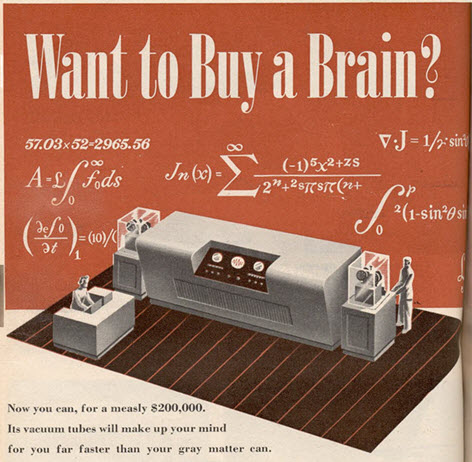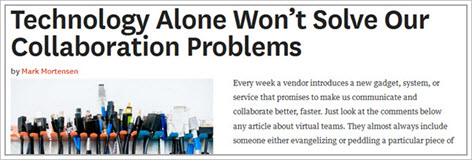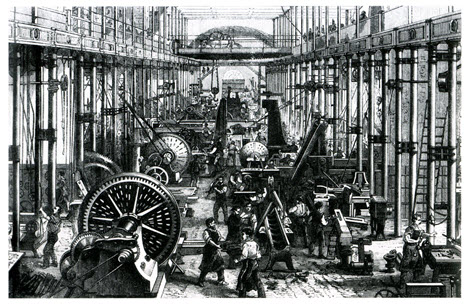"I’ve heard we’re switching to Outlook/Verse/something else, so why should I invest in eProductivity until then?"
Thursday, June 18th, 2015Here's a practical application: I was recently talking with a client about expanding eProductivity usage at his company. He wasn't sure he wanted to, because, he said, "I've heard our company is switching from Notes to Outlook in the next year."
I responded, "Ok; let me ask you, then: would you like your people to get things done at their current level for that time, then reduce that level as you switch?— Or, would you rather get a proven productivity benefit within days, then enjoy that benefit for the next year, and give your people skills and habits to use with any tools?"
Look at this way: if your employees' job was to cut boards, but they were using dull saws, would you leave them well enough alone for a year?
Carpe annum (seize the year)
Whether you're going to be using your current tools (e.g., IBM Notes) for a short or long time, it's good to consider how much value you're getting from them. In most cases, it's not hard to sharpen the saw to get incredible value.
"Value" can be measured in a number of ways:
- How quickly you get things done
- How much of your effort is directed towards the right things to get done
- How confident and focused you are at work
- The speed and precision of your decisions
- Your ability to quickly process inputs and recalibrate
The fact is, the jobs of you and your team are more complicated than cutting boards. Your job, together, is to create value (all of the above and more) for the organization. So the question again is: what if you could use a tool now, with minimal investment, that's designed to make all of this easier?
what if you could make your current tools even easier to use and more productive with minimal investment and effort?
what if you could use a tool that's designed to make all of this easier?
The only thing worse . . .
A senior manager once told Zig Ziglar that he didn't want to waste money training his people only to have them leave. Zig's response was, "The only thing worse than training someone and losing them, is not training them and keeping them."
I take the same view on giving people good tools now. The only thing worse than giving them great tools and losing them, is not giving them great tools and keeping your current level of accomplishment. You can stay there, or get better.
The bottom line
My clients and I have seen eProductivity work hundreds of times. Some of them have even gone out of their way to measure how well it works (ask me for the impact report from PUMA).
I've seen people become more confident, relaxed, de-stressed, in-control, effective, and efficient after only a few weeks (or days) of using it. I've even come back to those people weeks or months later and found they're still working effectively. In some cases, they've even built on what they've learned and moved beyond it!
I've had the privilege of working with some forward-thinking managers and executives who've chosen to help their people. Because of that, they and their teams have gotten more from their systems and learned to think differently about how they work— and they know that what they've learned can be applied to the future to create greater value, no matter what tools they're using.
The client's decision
To me, the decision to give people great tools now and get the most from them is unmistakably clear. It was for my client as well: he decided to expand eProductivity among his people, and he considered it an investment.
He knew it would immediately boost his team's productivity for as long as they were using it. He knew the switch to Outlook may or may not come, but he wasn't deterred from investing in his people by improving their toolkit and skills.
His time, place, position, needs, and team were not unique, and this was his decision. What's yours?
When you're ready to invest in your tools and get greater value in return, give me a call. I can help.
Worth your time
- Nätcasino Utan Svensk Licens
- Siti Scommesse Non Aams
- Non Gamstop Casinos
- Casino Sites Not On Gamstop
- Casino Sites Not On Gamstop
- UK Casinos Not On Gamstop
- I Migliori Casino Online
- Casino Non Aams
- Casino Sites UK
- UK Casino Not On Gamstop
- Casino En Ligne
- Non Gamstop Casino UK
- Non Gamstop Casino
- Non Gamstop Casino
- Non Gamstop Casino UK
- Casino Sites Not On Gamstop
- Non Gamstop Casinos
- Casino En Ligne Meilleur Site
- Meilleur Casino En Ligne Avis
- Gambling Sites Not On Gamstop
- UK Casino Sites Not On Gamstop
- Gambling Sites Not On Gamstop
- Non Gamstop Casino
- Casino Sites Not On Gamstop
- Migliori Casino Italiani Online
- Meilleur Casino En Ligne En Belgique
- Casino Con Prelievo Visa
- Meilleurs Site De Paris Sportif
- русские букмекерские конторы
- Crypto Bookmaker
Best Practices for Robotics Competitions, Work, and Life in General
Wednesday, May 6th, 2015 I really enjoy consulting and coaching executives and other professionals, because it allows me to make a difference in the lives of others. There's nothing like that moment when their eyes widen and they say "I get it!" or "That's cool!"
I really enjoy consulting and coaching executives and other professionals, because it allows me to make a difference in the lives of others. There's nothing like that moment when their eyes widen and they say "I get it!" or "That's cool!" I also get to experience this same thing with students in my Intro to Robotics course. This course isn't just a bunch of computer science geeks doing geeky things: I use it to prepare my students to work well, both in their personal and professional lives, by teaching them essential life skills.
I know teaching life skills through robotics sounds far-fetched, so I'm going to prove it below.
 In this course, one of the exercises I teach is the After-Action Review. This consists of five questions:
In this course, one of the exercises I teach is the After-Action Review. This consists of five questions: 1. What was supposed to happen?
2. What actually happened?
3. Why did it happen?
4. What did we learn?
5. How can we do better next time?
On Monday, as I lead them through an After-Action Review, I wrote the answers to the final question on the board (as you can see on the left). The action under review was the students' preparation for their final in-class competition (which involved designing and building a robot in teams), but the answers they came up with also translate to work and life in general.
Note that these are not in order of importance or priority. They're all lessons learned. Here's what my students had to sayplus applies to best practices for life:
Continue Reading "Best Practices for Robotics Competitions, Work, and Life in General" »
Technology alone won’t fix how we work (and work together)
Monday, May 4th, 2015My first paid consulting job convinced me that technology would solve all our problems. Over 30 years ago, I was writing flight-planning programs with a 1-kilobyte* programmable calculator, and it was incredible: calculations that took hours by hand were done in a few minutes.
What I didn't see then was the whole picture. Technology is (and always has been) only part of the equation. My client and I had to put our knowledge together: his knowledge of the math needed for flight-planning, and my knowledge of how to write that into a program.
What I've discovered is that machines can never do our thinking for us – even though advertisers have been claiming they can for decades. Exhibit A:

"Its vacuum tubes will make up your mind for you far faster than your gray matter can." Somehow I'm reminded of modern ads claiming that technology can decide what's important to you.
What I found out
During my graduate research on how people work. I saw that even people with the best technology could work very ineffectively. At the same time, some people could use outdated equipment – even as simple as pen and paper – and create great value for their organization. Obviously, technology alone didn't make people better workers.
It became clear that technology is useless if people don't know how to work with it – and more importantly, use it to work together.
Based on my experience and research, I came up with this equation as a model for the effectiveness of individuals and teams:
Value (V) = Knowledge (K) x Methodology (M) x Technology (T)
Technology is literally only part of the equation. There are two other factors:
- Methodology: the habits, rules, and practices that people follow to get work done. In other words, how people work.
- Knowledge: what you know, who you know, and what they know
Let me go back to the flight-planning example:
- K = my client's knowledge of the mathematics needed for flight-planning
- M = my process for translating that math into programs
- T = the 1-kilobyte programmable calculator
Without all three, our operation wouldn't have worked and I would've been out of a job.
A kindred spirit
I was delighted to come across a very insightful article that Mark Mortensen of INSEAD recently wrote for the Harvard Business Review: "Technology Alone Won't Solve Our Collaboration Problems." He emphasizes "a simple truth: it’s not what technology you’ve got, but how you use it" and includes three specific examples of how to work more effectively with today's technology.
I'm glad to find someone who recognizes "it’s less important which technology you choose and more important that you align it with how people do work." Mortensen acknowledges the importance of method and knowledge as well as technology. See here for his article.

Three factors to success
The interaction of knowledge, methodology, and technology is critical to any organization's success and the value of any individual's work. This is what I've brought to my consulting clients over my decades in the field, and I've clearly seen the results: it works.
To share your thoughts on this topic, connect with me on social media (below). When you're ready discuss how I can help you and your organization manage the balance of KMT, click "Contact" in the upper-right. I'd love to chat!
Best,
Eric
*For the younger crowd: 1 kilobyte is about 1/16,000,000 of the memory of a standard iPhone 6.
Image credit:
"Buy a Brain" image by DigiBarn [CC BY-NC 3.0 (http://creativecommons.org/licenses/by-nc/3.0/)]. Changes made: image rotated clockwise 1 degree; article text cropped out; additional border coloring added. Scanned by DigiBarn from Popular Science, May 1949. Link to original image: http://www.digibarn.com/collections/mags/popsci-may-1949/brain1.jpg
Email is not the problem. Lack of agreement on how to use it is.
Wednesday, March 25th, 2015
I've been working with electronic messaging (email, etc.) in one form or another for over 30 years. Back in 1992, I (successfully) sold a server-software product that promised to help people deal with the "flood" of 40 emails a day! Much of my executive coaching business has revolved around helping professionals manage their email (many receive up to 400 a day).
I've had a front-row seat to the rise of email along the whole way. For many people, it's grown into a monstrous beast. A couple years ago, McKinsey & Company found that workers spend up to 28% of their day writing and reading emails. Inboxes fill up over lunch breaks. We're all guilty of being to quick to send to others whose email is just as out-of-control as ours.
I think that's at least half of the issue: who's creating the problem. I also think we can definitely find ways to address this together.
Continue Reading "Email is not the problem. Lack of agreement on how to use it is." »
Moving from Outlook to Lotus Notes (or vice versa)? It might not actually matter, and here’s why
Friday, March 20th, 2015Why would this ever happen, since so many people seem to like Outlook better than Notes? Does the migration even matter?
Honestly, I don't think these switches matter nearly as much as many people think they do (Microsoft's drum-beating notwithstanding). Here's why: many companies have migrated to Outlook after their employees have screamed to kill Notes (or, more often, after they were bought by an Outlook company), and you know what happened?
Continue Reading "Moving from Outlook to Lotus Notes (or vice versa)? It might not actually matter, and here's why" »
Why you don’t have time to save time
Thursday, March 12th, 2015
In other words, you're using an outdated definition of what it means to be productive:
Productivity
Noun
[obsolete]
1. The process of producing more output with less input: "working harder."
[modern]
2. The art of accomplishing more with less time and less energy, achieved by learning new ways of doing things.
Which one would you rather use?
Continue Reading "Why you don't have time to save time" »






